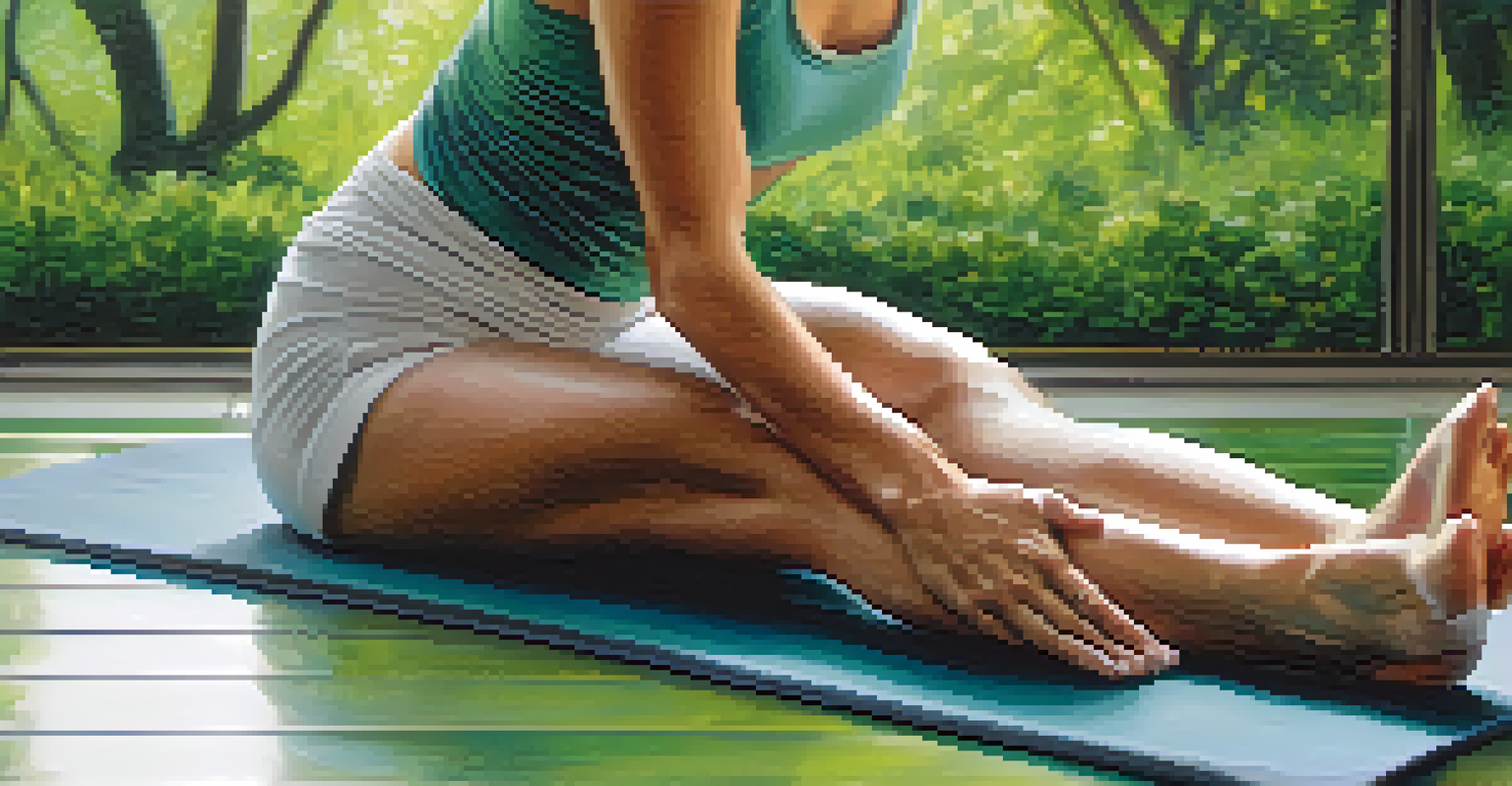Using Yoga Props to Support Your Posture Practice

Understanding the Importance of Posture in Yoga
Posture plays a critical role in yoga, influencing both our physical and mental well-being. Proper alignment not only enhances the effectiveness of each pose but also helps prevent injuries. When we maintain good posture, we allow for better breathing, increased energy flow, and improved focus during practice.
The body is your temple. Keep it pure and clean for the soul to reside in.
Many practitioners struggle with maintaining correct posture, especially in more advanced poses. This is where yoga props come into play, offering support and guidance. By using props, you can find the right alignment and build strength gradually, making your practice more enjoyable and sustainable.
Ultimately, good posture is about more than just looking good; it's about feeling good. Whether you’re a beginner or an experienced yogi, understanding the significance of posture can transform your practice and overall health.
Common Yoga Props and Their Benefits
Yoga props come in various forms, including blocks, straps, bolsters, and blankets. Each prop serves a unique purpose, making yoga accessible to individuals of all levels. For example, blocks can help you reach the ground in poses like forward bends, while straps can assist in achieving deeper stretches.

Using these props can enhance your stability and comfort during practice. They can be particularly helpful for those with limited flexibility or strength, providing the necessary support to gradually improve. By incorporating props, you can explore new dimensions of your practice without the fear of strain or injury.
Posture Enhances Yoga Practice
Maintaining proper posture improves both physical alignment and mental focus, enhancing the overall effectiveness of yoga.
Moreover, props can deepen your understanding of alignment. They serve as tools for self-discovery, guiding you to feel where your body needs adjustment and how to maintain balance in each pose.
How to Use Yoga Blocks to Improve Alignment
Yoga blocks are versatile and can be used in many poses to enhance alignment. For instance, when practicing triangle pose, placing a block under your lower hand can help you maintain proper alignment without overstretching. This support allows you to focus on opening your hips and chest, rather than straining to reach the floor.
Yoga is the journey of the self, through the self, to the self.
Additionally, blocks can be used in seated poses to elevate your hips. This elevation can relieve tension in your lower back and improve the quality of your breath. By using blocks strategically, you can create a more comfortable and effective practice, allowing for deeper exploration.
Remember, the goal of using blocks is not to limit your practice but to expand your possibilities. They provide a bridge to better form and deeper understanding, enabling you to cultivate strength and flexibility over time.
Using Straps for Enhanced Flexibility and Reach
Straps are another fantastic tool for enhancing your yoga practice. They can assist you in achieving poses that require flexibility you may not yet have. For example, when practicing seated forward bends, using a strap around your feet can help you maintain a straight back while gently pulling yourself forward.
In addition to aiding in stretches, straps can also help with alignment. For instance, when practicing poses like downward dog, placing a strap around your wrists can ensure they stay shoulder-width apart, preventing strain on your shoulders. This small adjustment can make a significant difference in how the pose feels.
Yoga Props Support All Levels
Using props like blocks and straps makes yoga accessible and helps practitioners gradually improve their strength and flexibility.
Using straps encourages a mindful approach to your practice. They remind you to listen to your body, respecting its limits while inviting you to explore new ranges of motion safely.
Incorporating Bolsters for Comfort and Support
Bolsters are large, firm cushions that can provide exceptional support in restorative yoga poses. For instance, during gentle backbends, you can place a bolster under your spine, allowing for a gentle opening of the chest without discomfort. This support encourages relaxation and deeper breathing, enhancing the restorative benefits of the practice.
Moreover, bolsters can be utilized in seated poses to elevate the hips, similar to blocks. By providing a comfortable base, bolsters help reduce tension in the lower back and promote better posture. This is especially beneficial for those who may struggle with sitting up straight for extended periods.
Incorporating bolsters into your practice is about embracing comfort. They invite you to slow down, tune into your body, and cultivate a sense of ease, which is essential for a fulfilling yoga experience.
Blankets: Versatile Support for Every Pose
Yoga blankets are often overlooked but can be incredibly versatile in enhancing your practice. They offer warmth and cushioning, making them perfect for restorative poses or as padding under your knees in lunges. A simple blanket can transform your practice by providing extra comfort where needed.
In addition to physical support, blankets can also be used to modify poses. For example, when practicing seated poses, folding a blanket can create a slight elevation, helping to alleviate discomfort in the hips. This small adjustment can lead to a more aligned and comfortable posture.
Create a Comforting Practice Space
A supportive environment with props encourages safety and mindfulness, allowing for a more transformative yoga experience.
The beauty of using blankets lies in their adaptability. Whether you need support, warmth, or a bit of extra height, blankets can seamlessly fit into various poses, enhancing your overall experience.
Creating a Supportive Environment with Props
Incorporating props into your practice isn’t just about the tools; it’s also about creating a supportive environment. When you surround yourself with the right props, you invite a sense of safety and comfort into your practice. This environment allows you to explore poses more freely, without the fear of injury.
A well-prepared space encourages a more mindful practice. By having props like blocks, straps, and bolsters within reach, you can easily make adjustments as you move through your routine. This accessibility fosters a deeper connection between your body and mind, enhancing your overall practice.

Ultimately, a supportive environment empowers you to focus on your breath and inner experience. With the right props at your disposal, you can cultivate a practice that feels both safe and transformative.
Embracing the Journey of Your Yoga Practice
Using yoga props is all about embracing the journey of your practice. Rather than viewing them as crutches, think of them as tools to enhance your experience. Each time you reach for a block or strap, you’re giving yourself permission to explore and grow without limitations.
This mindset shift can be liberating, allowing you to approach your practice with curiosity. As you become more attuned to your body and its needs, you'll find that using props can open up new possibilities within your poses. It’s about finding what works for you and celebrating your unique journey.
Remember, yoga is not a destination but a lifelong journey of self-discovery. By incorporating props, you invite support and compassion into your practice, helping you to honor where you are today while cultivating a sense of growth for tomorrow.